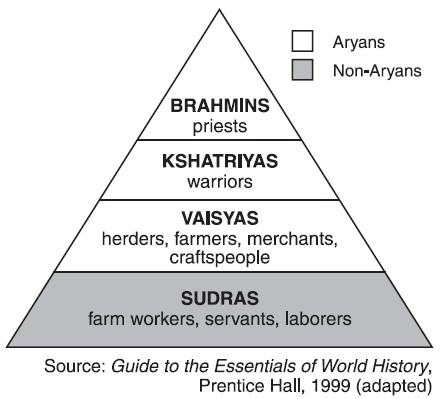Travel Tips
Lorem ipsum dolor sit amet, consectetur adipiscing elit.

Theories of origin of Caste System in India
According to this theory, the caste system is of divine origin and it is extension of the varna system. Chatura varnas were originated from the body of Bramha. 
Brahmins (mainly teachers and intellectuals) is on top of Varna hierarchy and came from Brahma’s head.
Kshatriyas ( the warriors and rulers) came from his arms.
Vaishyas (the traders) were created from his thighs.
Shudras (Serving Class/Domestic Servants) were at bottom, who came from Brahma’s feet.
The mouth signifies its use for preaching, learning etc, the arms – protections, thighs – to cultivate or business, feet – helps the whole body, so the duty of the Shudras is to serve all the others. The sub castes emerged later due to inter marriages between the 4 varnas.
The proponents of this theory are Purushasukta of Rigveda, Manusmriti etc
The Sanskrit word for caste is varna ( means colour). Indian sociologist D.N. Majumdar writes in his book, “Races and Culture in India”, the caste system took its birth after the arrival of Aryans in India.
In order to maintain their separate existence the Indo-Aiyans used for certain groups and orders of people the favourite word ‘varna’, ‘colour’. Thus they spoke of the ‘Dasa varna’, or more properly the Dasa people.
Rig Vedic literature stresses very significantly the differences between the Arya and Dasa, not only in their colour but also in their speech, religious practices, and physical features.
According to this theory, caste system is a clever device invented by the Brahmins in order to place themselves on the highest ladder of social hierarchy.
Dr. Ghurye states, “Caste is a Brahminic child of Indo-Aryan culture cradled in the land of the Ganges and then transferred to other parts of India.”
The Brahmins even added the concept of spiritual merit of the king, through the priest or purohit in order to get the support of the ruler of the land.
Nesfield, said that occupation is the main base of origin of the caste-system. Some of the occupations are considered superior while others are considered inferior and so, on the basis of the superiority and infirmity of these occupations, the followers of these occupations were considered superior and inferior.
As a result of this, caste-system was born. All those who carried out functions of the Purohits were considered superior. As a result of the complications of the religion customs and traditions, Purohits had to take to specializations. Thus all those, who knew this specialized takes were considered Brahmins and superior to others.
As the time is past, they organised themselves into a group and called themselves Brahmins. Similarly follows of other occupations also organised them into a group or a class and so the system of Caste or Caste System developed. Nesfield reconginised functions as slow basis of Caste System.
According to this theory, the caste system is the result of a long process of social evolution. It did not come into existence all of a sudden or at a particular date.
Among these factors we may enumerate the following ones:
(i) Hereditary occupations;
(ii) The desire of the Brahmins to keep themselves pure;
(iii) The lack of rigid unitary control of the state;
(iv) The unwillingness of rulers to enforce a uniform standard of law and custom and their readiness to recognize the varying customs of different groups as valid;
(v) Beliefs in re-incarnation and the doctrine of Karma;
(vi) Ideas of exclusive family, ancestor worship, and the sacramental meal;
(vii) Clash of antagonistic cultures particularly of the patriarchal and the matriarchal systems;
(viii) Clash of races, colour prejudices and conquest;
(ix) Deliberate economic and administrative policies followed by the various conquerors particularly by the British;
(x) Geographical isolation of the Indian peninsula;
(xi) Static nature of Hindu society;
(xii) Foreign invasions;
(xiii) Rural social structure.
All the above factors conspired to encourage the formation of small groups based on petty distinctions from time to time. The lack of rigid unitary control of the state, the unwillingness of the rulers to enforce a uniform standard of law and custom, their readiness to recognize the varying customs of different groups as valid, and their usual practice of allowing things somehow to adjust themselves led to the growth of groups and promoted the spirit of solidarity and community feeling in every group.
“Multiplicity of the groups and the thoroughness of the system are also due to the habit of the Hindu mind to create categories and to carry things to their logical end a characteristic manifest in our literature, philosophy and religious creeds.”
It may, however, be noted that caste system is not specifically an institution of the Hindus but is a typical Indian institution. Buddhism in its practice at least was not opposed to the caste system and the two primary attributes of interlining and intermarriage between different hereditary determined sets of people in the same community are also found among the Moslems of India.
Further, caste system, is not a monopoly of India. It existed and still exists in many parts of the world. The feudal system of medieval Europe was a species of caste system. Certain ethnic groups such as Jews and Negroes are still treated as castes in many civilized countries including the United States. What is unique in the Hindu caste system is that it alone classified some groups as untouchable and unapproachable.
Article Written By Ashish Kumar (All India Top Scorer in Sociology in CSE-2016,)